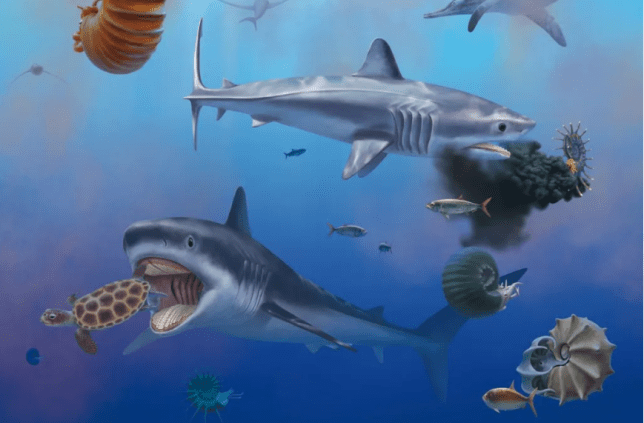The great white shark has an ancestor with teeth so sharp, it could chew through a turtle’s shell.
Researchers have finally uncovered the prehistoric shark after years of odd clues suggesting there was something more terrifying lurking in our seas millions of years ago.
Now, in a quarry in Mexico, scientists reveal exactly what the sharks looked like – right down to the shape of their teeth.
Scientists uncover great white relative
These prehistoric sharks have been hinted towards since their fossils were first discovered in the mid-eighteenth century.
But now, a team of researchers have found complete fossils from an enormous prehistoric shark that lived alongside the dinosaurs.
The shark is from the genus Ptychodus – a group of extinct creatures that roamed the seas from around 105m to 75m years ago.
But as shark’s skeletons are made of cartilage, researchers often would find isolated teeth hinting at the monsters in the sea.
This also made it difficult for researchers to say what Ptychodus looked like and where it sat on the evolutionary family tree.
But now researchers have found complete skeletons of the creatures in small quarries in north-eastern Mexico.
First author Dr Romain Vullo said: ‘Its general appearance has remained a mystery up to now because of the lack of more complete material during almost two centuries.
‘The discovery of the new specimens from Vallecillo, revealing the body shape and anatomy of this extinct shark, solves this enigma.’
Dr Vullo and colleagues reported on the six Ptychodus specimens, dating from about 93m years ago.
One fossil revealed a side view of the sharks, containing not only almost all its skeletal elements but also teeth, preserved muscle remains and a body outline complete with all its fins.
Three of the specimens were almost complete, and the remaining two were incomplete or partial skeletons.
What did the prehistoric sharks look like?
The researchers reveal the fossils belonged to the mackerel shark group, which includes the extinct gigantic shark megalodon, the great white shark, and salmon sharks.
The dimensions of the prehistoric creature, such as its overall body shape and proportions as well as the positions of its fins, suggest it was a fast-swimming shark.
The sharks grew to around 10 meters in length and had massive, grinding teeth.
The team suggest that the Ptychodus hunted prey in open water, with its meals probably comprising sea turtles and ammonites rather than creatures such as clams that dwelled on the sea floor.
Dr Vullo said: ‘Ptychodus was generally thought to be morphologically similar to benthic sharks like the modern nurse shark, but we now know that it looked like the extant porbeagle shark, a fast-swimming pelagic form.’
The study is in the Journal of Proceedings of the Royal Society B.
MORE : China creates world’s fastest humanoid robot – but there’s something odd about how it moves
MORE : How just 20 seconds of exercise could save your life
MORE : Inside Nasa’s £3,350,000,000 Dragonfly mission to Saturn’s moon Titan
Get your need-to-know
latest news, feel-good stories, analysis and more
This site is protected by reCAPTCHA and the Google Privacy Policy and Terms of Service apply.















